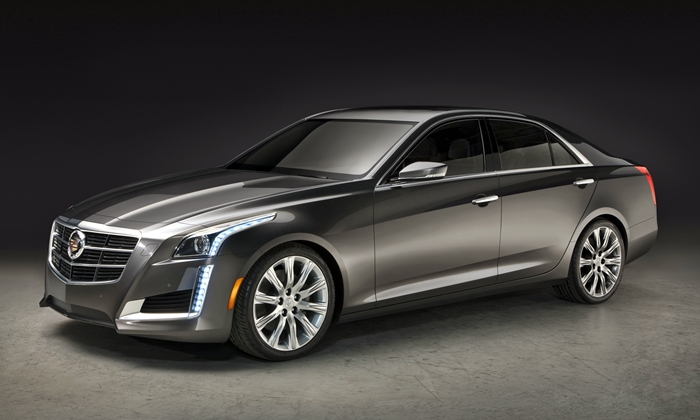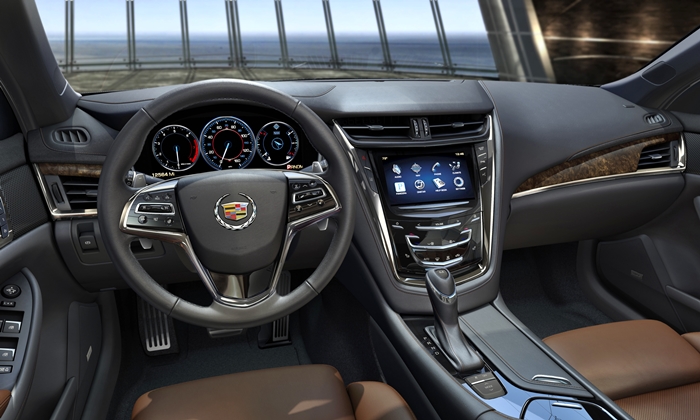Yesterday Cadillac revealed the 2014 CTS at the New York auto show. In its third iteration, will the car finally threaten the dominance of the Germans? In many ways I’m impressed, but in one I’m also discouraged.
The first-generation CTS introduced Cadillac’s daring, stealth fighter-inspired “art and science” design language. Five years later, the second-generation CTS refined both the styling and behavior of the car, but added hundreds of pounds. The result was a car that, while distinctive and attractive, was far too large to compete with the BMW 3-Series and Mercedes-Benz C-Class but without the interior space or features to compete with the 5-Series and E-Class.
With the ATS now going head-to-head with the 3 and C, Cadillac is pitching the new CTS directly against the 5 and E. They claim that the previous car fell between classes in size, but the new, larger one does not. This is not entirely accurate. It’s barely partially accurate. The exterior of the old car was already about as large as the BMW and Mercedes. But it wasn’t quite as large as the BMW and Mercedes inside. And, guess what? The interior dimensions of the new car are within a few tenths of an inch of the old one. It’s as if they barely increased headroom and shoulder room so that they could claim an increase. Total legroom is even down a little.
Notably, the BMW 5-Series will continue to provide about an inch-and-a-half more shoulder room. This might not seem like much, but it can be the difference between a car feeling roomy and, well, not. The difference between the compact ATS and the new CTS is only 1.7 inches in front, and less than an inch in back.
The current CTS’s legroom SPECS have been competitive. The problem is that the rear seat cushion is low and under-sized, so the rear seat feels much less roomy than it actually is. If they’ve more intelligently packaged the rear seat, then the new CTS could be much more comfortable in back even if it’s not actually roomier.
The CTS’s exterior grew more than its interior. In length, at least, which is up by nearly four inches. Height and width have actually been trimmed by 0.8 inches and 0.3 inches, respectively. Where did the additional length go, if not the passenger compartment? Not the trunk, which has grown by only 0.1 cubic feet–another tiny bump just to claim one? Perhaps the new car’s hood is longer.
To match the German’s, the CTS’s width needed to grow about an inch, but shrunk a little instead. The 5-Series is an inch wider, and as mentioned above this helps give it a significantly wider interior. Why isn’t the new car wider? Perhaps because it’s based on the same “Alpha” architecture as the ATS, and it wasn’t possible to expand its width any more.
The current CTS also has lagged the Germans in interior materials and features offered. Both of these shortfalls are eliminated with the new car. Cadillac’s most recent interiors have been excellent, and that in the new CTS could be the best yet. The car will offer a full array of infotainment and safety features. If the Germans offer it, with few exceptions the new Cadillac will as well.
The current CTS has also lagged in the breadth of its engine options. The new one will offer a 272-horsepower 2.0-liter four-cylinder engine (replacing an equally powerful but much less torquey 3.0-liter V6), a 321-horsepower 3.6-liter V6 (similar to the current engine), and a 420-horsepower twin-turbo V6. This last, on paper at least, matches the power output and fuel economy of the larger turbocharged V8s offered in the Germans. An imported-from-Japan eight-speed automatic will be optional with the base V6 and standard with the twin-turbo. No manual transmission will be offered. AWD will be offered with the first two engines, but not the most powerful one.
If the top-level CTS is actually quicker than the German V8s, as Cadillac is claiming, this will be due to the largest technical achievement of the new car. Reversing recent trends, and then some, the new CTS is about 200 pounds lighter than both the current CTS, 5-Series, and E-Class. Credit is largely due to much more extensive use of aluminum, including the doors. Some news outlets have been assuming that the touted curb weight of 3,616 pounds applies with the top engine. But this is the curb weight with the four-cylinder. With the turbo six the new CTS will weigh 3,952 pounds. Still admirable; a BMW 550i burdens the scales with 4,365 pounds. The ATS is the best-handling car in its segment. With this low curb weight and many similarities to the ATS, the new CTS might achieve the same distinction.
Fuel economy isn’t as good as it should be. Looking at the most powerful engine, the new CTS matches the EPA ratings of the 550i. But with two fewer cylinders, 0.8-liters less displacement, and over 400 fewer pounds to tote around, it should have a significant mpg advantage. The other two engines fail to match the 5-Series. Cadillac is predicting EPA ratings of 19/30 for the 2.0T, vs. 24/34 for the same size engine in the BMW 528i. The CTS V6 will likely be rated 19/28, vs. the 535i’s 20/30. The BMW’s ratings are suspiciously high, and might yet be revised downward (like the 328i’s were last year). GM a;sp has a tendency to be conservative with its EPA forecasts. So perhaps when the car arrives and official EPA numbers are released these shortfalls won’t be as large.
The new CTS hasn’t grown nearly as much as Cadillac suggests, but interior shoulder room did manage to grow a smidge even though the exterior is narrower. How did they manage this? My eyes suggest by removing curvature from the body sides. The new CTS’s fenders lack the voluptuous flares of the current ones. In general, the new design is far less bold, the only exception being the front LED-filled front corners. Aft of the headlights, the new car could almost pass for an E-Class (much like the ATS could almost pass for a C-Class). This is my greatest disappointment with the new CTS, ahead of even the MPG figures. While others are praising the new design’s elegance, I see a continued retreat from the bold original to something much more safe and generic. Will the new design sell better? Quite likely. People claim to like bold, distinctive designs…until it comes time to buy.

